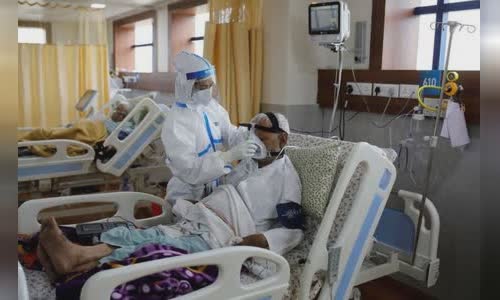Globally more than one million deaths of nCoV are recorded in more than 34 million infected people, while WHO reassures the world that Covid-19 'can stop'.
213 countries and territories recorded 34,128,089 cases and 1,017,838 deaths caused by nCoV, an increase of 350,553 and 7,260 cases after 24 hours, 25,388,440 people recovered, according to the update page.

Medical staff care for patients in the suburbs of New Delhi, India on September 15 Photo: Reuters
The US, the world's largest epidemic zone, recorded 7,442,002 cases and 211,634 deaths, an increase of 45,002 and 1,010 cases from a day earlier.
New vitality is slowly returning to Washington, DC, as many famous attractions begin to reopen after six months of shutdown, even though cinemas are closed and restaurants are only running at half capacity.
US President Donald Trump on September 28 announced plans to send 150 million sets of rapid tests to states to support pandemic control efforts, as the government is pushing to reopen schools and businesses.
India, the world's second largest epidemic region and Asia's largest, reported an additional 86,748 cases and 1,179 deaths yesterday, bringing the total number of people infected and dying from Covid-19 to 6,310,267 and 98,708, respectively.
Although the number of infections in India increased faster than any other country, the country's Ministry of Health still points to a positive sign that the cure rate has increased by almost 100% in the past month, adding that more than 82% of the total.
India reopened two weeks ago to the Taj Mahal after six months stopped welcoming tourists.
Brazil, the third largest epidemic region in the world, recorded an additional 952 deaths from Covid-19, bringing the total number of deaths to 143,962.
Brazilian experts say the models show that the country has passed the epidemic peak, but still warned that the situation could suddenly deteriorate if the local government allows the economic reopening too soon, without tightening the measures.
The city of Manaus, the capital of the state of the Amazonas, recently decided to close bars and riverside areas to curb a new nCoV outbreak.
Russia reported an additional 177 deaths, bringing the total number of deaths to 20,722.
Last week, the Kremlin said it had no plans to impose strict preventive measures despite the growing number of new nCoV infections.
South Africa, the world's 10th largest epidemic region and the country most heavily affected by the pandemic in Africa, recorded 674,339 cases and 16,734 deaths, up 1,767 and 67 respectively.
The South African government opened borders with all African countries from October 1, while still banning visitors from 50 countries with high rates of infection, including the UK, the US, India, Russia, and France.
Passengers arriving in South Africa are required to present a negative nCoV made within 72 hours of departure, or subject to mandatory isolation and pay for your own fee.
Cases rose again in Spain, the largest epidemic region in Europe.
Spain's central government on October 1 announced plans to blockade Madrid, the capital with three million people and 9 surrounding cities.
However, Madrid's local government opposed the decision, saying it had no legal basis.
The number of new infections in France also increased again after the period of Covid-19 was contained.
The French government recently stepped up measures to contain the virus, but has still managed to avoid a second national blockade.
Health experts are concerned that a new outbreak of nCoV, along with seasonal illnesses like the flu, could potentially worsen the situation very quickly.
He recorded 453,264 cases and 42,143 deaths, an increase of 7,108 and 71 cases, respectively.
The UK government announced to tighten social distancing measures in the northeastern region of the country from today, in response to the high and increasing rates of nCoV infection here.
Although cases are rising again in many parts of the country, the UK government has said it wants to avoid a second national blockade.
Iran, the Middle East's largest epidemic region, reported 26,169 deaths, an increase of 183, while the total number of infections was 457,219, an increase of 3,582.
In Southeast Asia, the Philippines is the region's largest epidemic with 311,694 cases and 5,504 deaths, up 2,426 and 58 respectively.
Philippine President Rodrigo Duterte on September 28 announced that the restrictions in the capital Manila and surrounding areas will be extended for another month, to October 31.
Most businesses have been allowed to reopen since Manila ended the blockade on August 19.
Indonesia, the region's second largest epidemic, recorded 287,008 cases, an increase of 4,284 from the previous day, of which 10,740 people died, an increase of 128 cases.
The capital Jakarta resumed large-scale social distancing measures from September 14, which went into effect for two weeks, due to a skyrocketing number of new infections.
Jakarta started to impose restrictions to prevent nCoV in early April, but loosen it up in June. However, a few weeks later, the number of new infections in the capital skyrocketed.
Singapore is the third largest epidemic area in the region with 23 deaths and 57,765 infections, an increase of 27 cases.
Singapore will pilot a travel card program for business leaders who need to travel on a regular basis, as they continue to relax some of the Covid-19 restrictions.
WHO spokesperson Margaret Harris yesterday admitted the global death of more than a million people from CoV is "a very sad milestone", adding that many victims have had to "hard and lonely" deaths.
However, Harris points out the "positive" thing about the pandemic is that it is "preventable, not the flu."
Updated: 6:51, 1/10 | Source: WorldOMeters



 Ratnesh Jain
Ratnesh Jain







